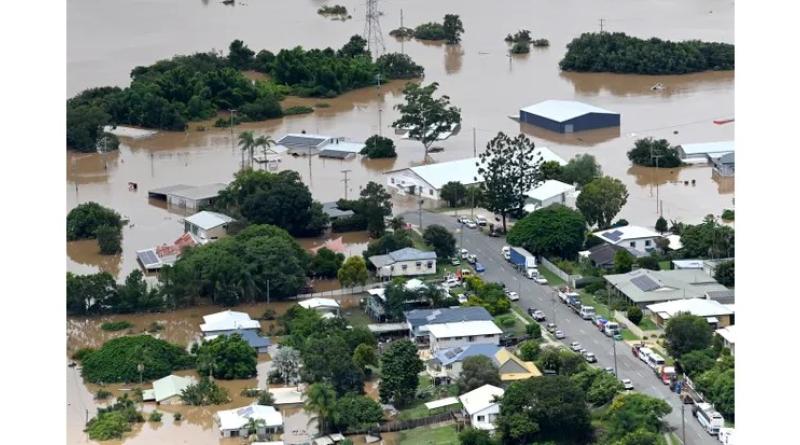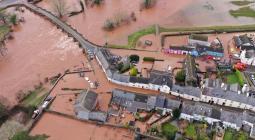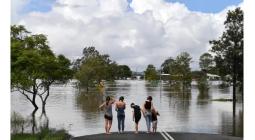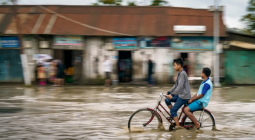Mayor defends planning decisions ‘made 150 years ago’ amid calls for flood insurance support

Home owners are being left to cover ‘catastrophic’ financial risks as the climate crisis and a legacy of poor planning coalesce, expert says
Two Queensland mayors of flood-ravaged towns on the Mary River have backed calls for the federal government to help underwrite insurance companies against future inundations.
The calls come as homeowners and small businesses brace for a potential rise in insurance premiums that could hit even those in neighbourhoods that did not flood, and push insurance out of reach for more people in those that did.
Gympie mayor Glen Hartwig and his counterpart in Maryborough, George Seymour, told Guardian Australia the commonwealth should expand its planned $10bn cyclone reinsurance pool in northern Australia to cover floods in the state’s south-east.
“The reality is that a lot of towns that have been around for a little while have to deal with the impact of decisions that were made 150 years ago on where some homes and some businesses were located,” Hartwig said.
“So, yes, assistance for individuals to deal with floods would be a good outcome.”
Set to become operational in July, the reinsurance pool effectively sees the commonwealth insure the insurance companies against huge losses if they offer disaster cover.
A federal Senate committee hearing into the reinsurance scheme last week prompted MPs from both sides of politics representing flood-affected communities to also back its expansion.
Seymour, the mayor of Fraser Coast regional council, said he hoped the government would, at the least, investigate “extending the scheme to include flooding”.
People in Brisbane also bore the brunt of policy decisions that have allowed homes to be built in areas – and with designs – that had left them at the mercy of flood waters.
Dr Di Johnson from Griffith University’s business school said it was individuals, households and small businesses who were left carrying potentially “catastrophic” financial risks while the climate crisis and a legacy of poor planning coalesce.
“When you have people who are paying premiums that are doubling or tripling in a year, then it is obviously market failure,” she said.
“That’s created a hidden cost, because it is a cost that is put on to individual citizens and particular communities, as if they were somehow at fault.”
Johnson said the reinsurance pool would be an important stepping stone toward preventing more homes from becoming uninsured.
“Frankly, if we are trying to support a viable and sustainable insurance market for natural disasters it already urgently needs to be extended – even before it has begun,” she said.
Brisbane’s lord mayor said the reinsurance pool was a matter for the federal government.
“We’re focused on Brisbane’s biggest ever clean up after the city’s biggest ever rain event,” Adrian Schrinner said.
While the Gympie mayor acknowledged that risk was “clearly being carried” by small businesses and residents, he said it was wrong to lay the blame solely at the feet of government or insurers.
“Part of the challenge we face in society is that everyone is looking to ostracise themselves from responsibility,” Hartwig said.
“If you go and buy a property that is built on a floodplain, there is the possibility that it may be inundated and you need to factor that into the sale price.”
“There is a responsibility right across the board, from the people that have purchased the property to the people that have sold it, to local governments that allowed that sort of development to occur and also insurance companies.”
Asked if their councils bear responsibility for the issue due to previous planning decisions, Schrinner said property buyers have access to “detailed information about flood risks” and can reduce the impacts of flooding, while Seymour said “all levels of government need to work together to ensure we have resilient communities”.
Suncorp and RACQ did not directly answer questions as to whether they would increase premiums as a result of the ongoing floods.
Suncorp said “high-risk locations” were being “challenged” by higher premiums as “we face worsening extreme weather”.
“In recent years, we have seen an increase in both natural hazards and reinsurance costs, which impacts premiums,” the insurer said.
But Griffith business school’s Dr Kirsten MacDonald warned homeowners could expect a new reality when their insurance was next up for renewal.
“Across the board those premiums are likely to go up, and disproportionately so in those existing flood zones, and the now-new flood zones,” MacDonald said.
“But it’s when the renewal date comes that these poor people are going to get that shock.”
However she said premium rises should not be inevitable and called on insurers to reward property owners who took action to minimise flood risk when calculating their insurance bill.
She said that houses which were raised above flood levels and constructed from materials which held up well against inundation, such as tiles and hardwoods, should pay lower premiums for insurance against flood, just as those who install extra security pay less for insurance against theft.
MacDonald also backed a broadened reinsurance pool to cover floods for areas where insurance was impossible, either because it was not available or where premiums were “at an extreme price”.
But not everyone is convinced that reinsurance pool would curtail surging home insurance premiums.
A three-year inquiry by the Australian Competition and Consumer Commission produced a report in late 2020 that recommended direct subsidies as a tool for bringing down premiums rather than the reinsurance pool the Coalition ultimately adopted.
The commission found reinsurance pools supported the insurance industry rather than improved affordability.
At least one insurance consultant warned the government fund was “going to get hammered” by repeated cyclones and argued instead for relocation and redesign in the face of the climate emergency.
One point on which proponents and critics of the scheme do seem to agree however is that, alone, it will not be enough to keep disaster insurance affordable in the long run.
“Even if that reinsurance pool was extended to cover a wider definition of natural disasters, it is just a Band-Aid, stopgap solution,” Griffith University’s Johnson said.
“Risk mitigation through public infrastructure, like the flood levees, the revised building codes, better drainage, planning and, of course, action on climate change.”
“Ultimately that is going to have the most impact to effectively and sustainably reduce premiums.”
Author:Joe Hinchliffe
Photograph: Bradley Kanaris






